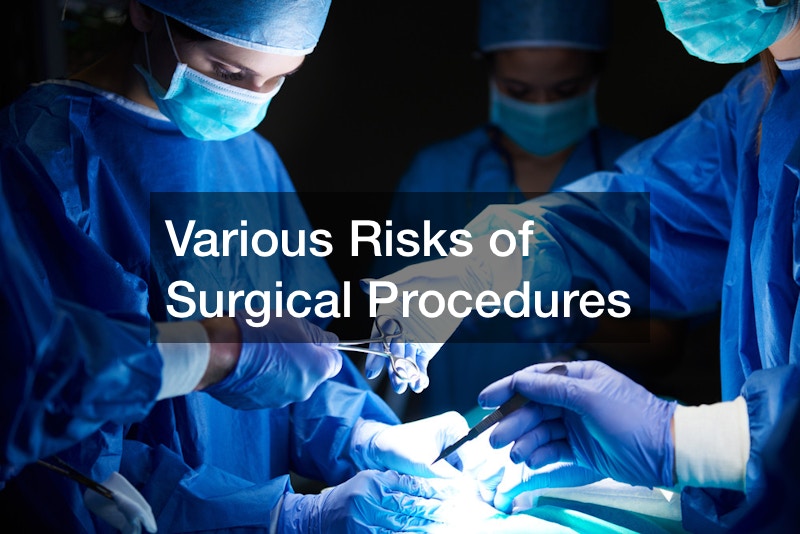Various Risks of Surgical Procedures


Surgical procedures, whether major or minor, come with a certain degree of risk. While these risks are generally low, it is important for patients to be aware of them before making a decision to undergo surgery. In this article, we will discuss the various risks that can occur with major and minor surgical procedures, as well as minimally invasive solutions that can help treat issues that are usually treated by major surgical procedures. After learning more, you’ll have better knowledge of some of the most popular surgery types, newer advances in both invasive and minimally invasive procedures, and some of the most important considerations for surgery choices in the future.
Popular Surgery Types

A cataract surgery procedure is a common procedure in which the cloudy lens of the eye is replaced with a clear artificial lens. The procedure is generally considered safe and effective, but there are some risks associated with it. These include infection, bleeding, and retinal detachment. In rare cases, patients may also experience vision loss or double vision. To minimize these risks, patients should carefully follow their surgeon’s instructions before and after the procedure. The eye is very delicate, and it’s important to move carefully with any choices made before, during, and after eye-related surgery.
Plastic surgery is another common type of surgery that can come with a certain degree of risk. Procedures such as breast augmentation, liposuction, and facelifts all have the potential to result in complications such as infection, bleeding, and poor healing. There is also a risk of dissatisfaction with the results, which can lead to additional surgeries. To minimize these risks, patients should carefully research their plastic surgeon and make sure they are board certified. In addition, they should also make sure they have realistic expectations of the results of the surgery. Plastic surgery inherently uses non-human material in the human body, and it’s important to not expect that plastic will perfectly mimic human organic material in terms of its look anywhere on the body.
Body sculpting is another type of surgery that has become increasingly popular in recent years. This type of surgery is used to remove unwanted fat and sculpt the body into a desired shape. The risks associated with body sculpting include infection, bleeding, and poor healing. There is also a risk of dissatisfaction with the results, which can lead to additional surgeries. To minimize these risks, patients should carefully research their surgeons and make sure they are board certified. They should also make sure they have realistic expectations of the results of the surgery, and maintain a healthy and active lifestyle regardless.
Dental Surgeries

Dentist-related surgeries such as a dental implant, wisdom teeth extraction, and root canal therapy also have their own set of risks. These risks include infection, bleeding, and nerve damage. To minimize these risks, patients should carefully research their dentist and make sure they are licensed. In addition, they should also make sure they have realistic expectations of the results of the surgery.
Tattoo removal is also a type of procedure that can come with risks. Traditional methods of tattoo removal such as dermabrasion and excision carry a risk of infection, bleeding, and scarring. However, laser tattoo removal is a minimally invasive solution that can help remove tattoos with fewer risks. This method uses laser energy to break up the ink particles in the tattoo, allowing the body to naturally remove them.
Legal Considerations
In addition to these risks, it’s also important to consider the potential legal risks associated with surgical procedures. Liability laws vary by state, but in general, a surgical practitioner may be held liable for any harm caused by a surgical procedure if they are found to have been negligent. Liability law can include things from failing to obtain informed consent, failing to properly diagnose a condition, or failing to properly treat a complication. Law firms, recruitment companies, and patches can all help in navigating the legal landscape of surgical procedures.
In conclusion, surgical procedures, whether major or minor, come with a certain degree of risk. While these risks are generally low, it is important for patients to be aware of them before making a decision to undergo surgery. Minimally invasive solutions such as laser tattoo removal can help reduce the risks associated with traditional surgical procedures. Patients should also research their surgeon, have realistic expectations of the results, and be aware of the legal risks associated with surgery.
Minimally Invasive Solutions

It is important to note that not all surgical procedures have to be invasive. Minimally invasive solutions have become increasingly popular in recent years as they offer patients many benefits over traditional surgical procedures. These include faster recovery times, less pain, and fewer complications.
Minimally Invasive Surgery Types
One such example is endoscopic surgery, which is a minimally invasive solution for conditions such as acid reflux and colon cancer. This type of surgery uses a thin, flexible tube with a camera and instruments attached to it. The tube is inserted through a small incision, allowing the surgeon to see inside the body and perform the procedure without making a large incision. This results in less pain, faster recovery times, and fewer complications.
Another example is laparoscopic surgery, which is a minimally invasive solution for conditions such as gallbladder disease and hernias. This type of surgery uses small incisions and specialized instruments to perform the procedure. The benefits of laparoscopic surgery include less pain, faster recovery times, and fewer complications.
Other Minimally Invasive Solutions
Minimally invasive solutions are also being used in the field of orthopedics. For example, arthroscopy is a minimally invasive solution for conditions such as knee and shoulder injuries. This type of surgery uses a small camera and specialized instruments to perform the procedure. The benefits of arthroscopy include less pain, faster recovery times, and fewer complications.
In the field of gynecology, minimally invasive solutions such as hysteroscopy and laparoscopy are also being used to diagnose and treat various conditions. These procedures use small cameras and specialized instruments to perform the procedure without the need for large incisions. This results in less pain, faster recovery times, and fewer complications.
Minimally invasive solutions are also being used in the field of urology, such as cystoscopy and ureterorenoscopy. These procedures use a small camera and specialized instruments to diagnose and treat conditions such as urinary tract infections and kidney stones. The benefits of these procedures include less pain, faster recovery times, and fewer complications.
Minimally invasive solutions are also being used for the treatment of varicose veins. These procedures use laser energy or radiofrequency to collapse the vein. This results in less pain, faster recovery times, and fewer complications.
Economic Benefits of Minimally Invasive Solutions

In addition to the medical benefits, minimally invasive solutions also have economic benefits. These procedures often require less time in the hospital and result in fewer complications, which can result in lower costs for the patient and the healthcare system.
Other Applications for Minimally Invasive Surgery
Another important minimally invasive solution that is becoming increasingly popular is robotic surgery. This technology allows surgeons to perform complex procedures using small incisions and specialized instruments that are controlled by a computer. The benefits of robotic surgery include improved precision, less pain, and faster recovery times. Robotic surgery is being used in a variety of fields such as gynecology, urology, and general surgery.
In the field of gynecology, robotic surgery is being used to perform procedures such as hysterectomies and myomectomies. This technology allows surgeons to perform these procedures with less blood loss and fewer complications than traditional surgery.
In the field of urology, robotic surgery is being used to perform procedures such as prostatectomies and nephrectomies. This technology allows surgeons to perform these procedures with less blood loss and fewer complications than traditional surgery.
In general surgery, robotic surgery is being used to perform procedures such as gastrectomies and colon resections. This technology allows surgeons to perform these procedures with less blood loss and fewer complications than traditional surgery.
Another important minimally invasive solution that is becoming increasingly popular is telemedicine. This technology allows patients to consult with their doctors remotely, using video conferencing. This can be especially useful for patients who live in remote areas or have mobility issues. Telemedicine allows patients to receive medical care without having to travel, which can save them time and money.
There are also new minimally invasive solutions that are being developed in the field of regenerative medicine. These include stem cell therapy and platelet-rich plasma therapy. These therapies use the patient’s own cells to promote healing and regeneration. These therapies are still in the early stages of development, but they hold promise for treating a variety of conditions, including osteoarthritis, tendinitis, and chronic wound healing.
Risks to Consider With Minimally Invasive Procedures
It is also important to consider the risks associated with these procedures. For example, there is a risk of infection with any surgical procedure, and this risk is increased with minimally invasive procedures due to the smaller incisions. Additionally, there is a risk of bleeding and nerve damage with any surgical procedure. These risks can be minimized by choosing a skilled surgeon and by following pre and post-operative instructions.
Another risk to consider is the possibility of complications or dissatisfaction with the results of the procedure. For example, in the case of plastic surgery, patients may not be satisfied with the results of the procedure or may experience complications such as infection or bleeding. It is important to have realistic expectations and to choose a qualified and experienced plastic surgeon to minimize these risks.
In the case of body sculpting procedures, there is also a risk of dissatisfaction with the results or complications such as infection or bleeding. It is important to choose a qualified and experienced surgeon and to have realistic expectations.
In the case of laser tattoo removal, there is a risk of burns, scarring, and changes in pigmentation. It is important to choose a qualified and experienced practitioner and to have realistic expectations.
In the case of cataract surgery, there is a risk of infection, bleeding, and complications with the implant. It is important to choose a qualified and experienced surgeon and to have realistic expectations.
Liability Considerations
It is also important to consider the issue of liability in the case of surgical procedures. Patients who are injured or unhappy with the results of a procedure may seek compensation through legal action. This is why it is important for surgeons and medical practitioners to have liability insurance and for patients to choose qualified and experienced practitioners.
In addition, patients should be aware of the role of recruitment companies and law firms in this area. Some of these companies and firms may offer to help patients find a qualified practitioner or to pursue legal action in the case of a bad outcome. It is important for patients to do their own research and to choose a practitioner based on qualifications and experience, rather than on the recommendations of a recruitment company or law firm.
In conclusion, minimally invasive solutions can offer many benefits to patients, including faster recovery times, less pain, and fewer complications. However, it is important to consider the risks associated with these procedures and to choose a qualified and experienced practitioner. Patients should also be aware of the issue of liability and the role of recruitment companies and law firms in this area. It is also important to consider that there are other solutions such as patches, creams, and other forms of therapy that may be used to treat issues that are usually treated by major surgical procedures. Just because a procedure can be attempted doesn’t mean it should in every situation. However, for many, minimally invasive solutions can have a profound benefit over time and increase the overall quality of life.


